燃气冷凝锅炉资料
福士德WNS2-1.25燃气蒸汽冷凝一体锅炉-产品介绍教学文稿
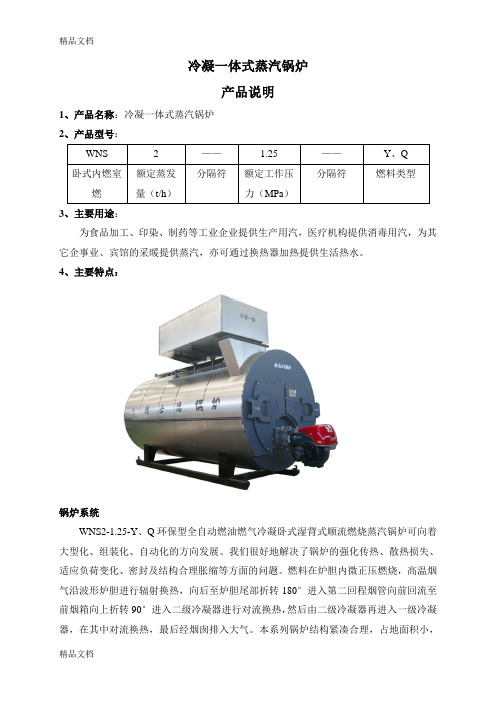
冷凝一体式蒸汽锅炉产品说明1、产品名称:冷凝一体式蒸汽锅炉2、产品型号:WNS 2 —— 1.25 ——Y、Q 卧式内燃室燃额定蒸发量(t/h)分隔符额定工作压力(MPa)分隔符燃料类型3、主要用途:为食品加工、印染、制药等工业企业提供生产用汽,医疗机构提供消毒用汽,为其它企事业、宾馆的采暖提供蒸汽,亦可通过换热器加热提供生活热水。
4、主要特点:锅炉系统WNS2-1.25-Y、Q环保型全自动燃油燃气冷凝卧式湿背式顺流燃烧蒸汽锅炉可向着大型化、组装化、自动化的方向发展。
我们很好地解决了锅炉的强化传热、散热损失、适应负荷变化、密封及结构合理胀缩等方面的问题。
燃料在炉胆内微正压燃烧,高温烟气沿波形炉胆进行辐射换热,向后至炉胆尾部折转180°进入第二回程烟管向前回流至前烟箱向上折转90°进入二级冷凝器进行对流换热,然后由二级冷凝器再进入一级冷凝器,在其中对流换热,最后经烟囱排入大气。
本系列锅炉结构紧凑合理,占地面积小,运行周期长,安装维修、运行操作方便。
配有意大利知名品牌“利雅路”燃烧器与锅炉充分配套,全自动程序控制和联锁保护,自动化程度高,可使锅炉在最佳状况下运行,热效率高,满足用户要求。
锅炉结构特点1)冷凝器双级布置,烟气余热梯级利用,内部采用无切削挤压螺旋翅片管,强化传热,排烟温度更低,热效率更高。
2)锅炉本体、二级冷凝器、一级冷凝器有机的结合为一体,安装简便易行,占地面积小。
3)根据炉膛辐射换热量和温度的四次方成正比的原理,我们优化了受热面的设计,波形炉胆总吸热量比例较大,具有良好的胀缩性。
4)轴对称向下偏置,湿背式顺流燃烧二回程结构,高温烟气全部聚集在前烟箱,后部烟温很低,直接用保温层保温,降低了维护费用;整体式前烟箱双开门设置,烟箱门双层密封,结构简单,便于开启、运行、操作和维护。
5)本锅炉采用硅酸铝、离心玻璃棉作为保温材料,其保温性能好、重量轻、运输安装方便。
6)锅炉上部设有人孔装置,下部设有清洗装置,便于维护和保养。
冷凝型燃气锅炉热效率

冷凝型燃气锅炉热效率
冷凝型燃气锅炉是一种高效率的暖气和热水供应设备,具有较高的热效率。
其热效率取决于燃气的燃烧效率和烟气中水蒸气的冷凝利用率。
一般而言,冷凝型燃气锅炉的热效率可达到90%以上。
其主要特点是在燃烧过程中通过烟气冷凝技术,将水蒸气中的热量回收利用。
具体的热效率取决于以下几个因素:
1.燃烧效率:冷凝型燃气锅炉通过优化燃烧技术,提高燃烧
效率来降低燃料的消耗。
燃烧效率指的是燃烧器将燃气高效地转化为热能的能力。
先进的燃烧器设计和控制系统可以实现高达98%以上的燃烧效率。
2.烟气冷凝利用率:冷凝型燃气锅炉在燃烧过程中,通过回
收烟气中所含的水蒸气中的热量来提高热效率。
这是通过冷凝烟气中的水蒸气并在热交换器中释放热量来实现的。
冷凝效果越好,热效率越高。
3.锅炉设计和技术:冷凝型燃气锅炉的设计和技术也会影响
热效率。
例如,采用高效的热交换器设计、优化的管路布置以及智能控制系统等可以提高热效率。
需要注意的是,冷凝型燃气锅炉的热效率是指在额定工况下的最高热效率。
实际使用中,对于不同的工况和运行状态,热效率会有所变化。
因此,在选择和使用冷凝型燃气锅炉时,要根据实际需求,考虑工况因素和货真价实的热效率指标。
此外,
定期的维护和清洁也对保持高热效率至关重要。
35t燃气低氮冷凝锅炉技术参数
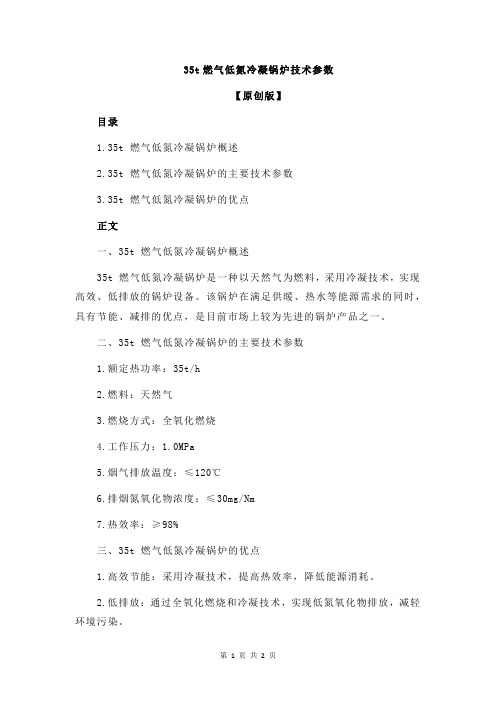
35t燃气低氮冷凝锅炉技术参数
【原创版】
目录
1.35t 燃气低氮冷凝锅炉概述
2.35t 燃气低氮冷凝锅炉的主要技术参数
3.35t 燃气低氮冷凝锅炉的优点
正文
一、35t 燃气低氮冷凝锅炉概述
35t 燃气低氮冷凝锅炉是一种以天然气为燃料,采用冷凝技术,实现高效、低排放的锅炉设备。
该锅炉在满足供暖、热水等能源需求的同时,具有节能、减排的优点,是目前市场上较为先进的锅炉产品之一。
二、35t 燃气低氮冷凝锅炉的主要技术参数
1.额定热功率:35t/h
2.燃料:天然气
3.燃烧方式:全氧化燃烧
4.工作压力:1.0MPa
5.烟气排放温度:≤120℃
6.排烟氮氧化物浓度:≤30mg/Nm
7.热效率:≥98%
三、35t 燃气低氮冷凝锅炉的优点
1.高效节能:采用冷凝技术,提高热效率,降低能源消耗。
2.低排放:通过全氧化燃烧和冷凝技术,实现低氮氧化物排放,减轻环境污染。
3.安全可靠:采用先进的燃烧控制技术,确保锅炉运行稳定,安全可靠。
4.占地面积小:采用紧凑型设计,占地面积小,便于安装和运输。
WNS燃气冷凝式蒸汽介绍(2015)
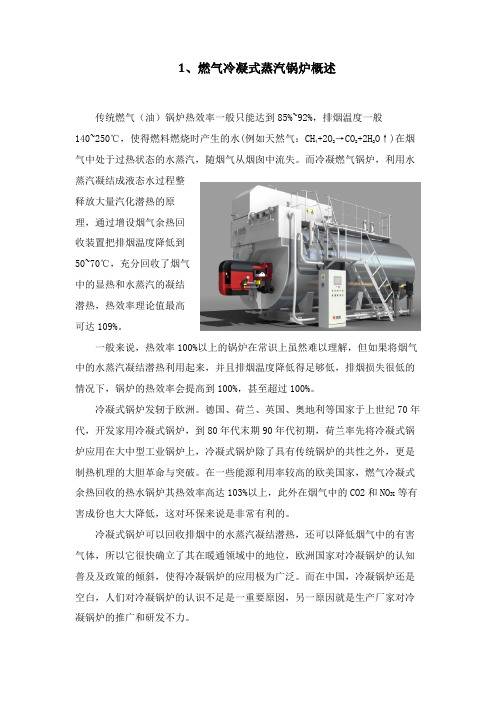
1、燃气冷凝式蒸汽锅炉概述传统燃气(油)锅炉热效率一般只能达到85%~92%,排烟温度一般140~250℃,使得燃料燃烧时产生的水(例如天然气:CH4+2O2→CO2+2H2O↑)在烟气中处于过热状态的水蒸汽,随烟气从烟囱中流失。
而冷凝燃气锅炉,利用水蒸汽凝结成液态水过程整释放大量汽化潜热的原理,通过增设烟气余热回收装置把排烟温度降低到50~70℃,充分回收了烟气中的显热和水蒸汽的凝结潜热,热效率理论值最高可达109%。
一般来说,热效率100%以上的锅炉在常识上虽然难以理解,但如果将烟气中的水蒸汽凝结潜热利用起来,并且排烟温度降低得足够低,排烟损失很低的情况下,锅炉的热效率会提高到100%,甚至超过100%。
冷凝式锅炉发轫于欧洲。
德国、荷兰、英国、奥地利等国家于上世纪70年代,开发家用冷凝式锅炉,到80年代末期90年代初期,荷兰率先将冷凝式锅炉应用在大中型工业锅炉上,冷凝式锅炉除了具有传统锅炉的共性之外,更是制热机理的大胆革命与突破。
在一些能源利用率较高的欧美国家,燃气冷凝式余热回收的热水锅炉其热效率高达103%以上,此外在烟气中的CO2和NOx等有害成份也大大降低,这对环保来说是非常有利的。
冷凝式锅炉可以回收排烟中的水蒸汽凝结潜热,还可以降低烟气中的有害气体,所以它很快确立了其在暖通领域中的地位,欧洲国家对冷凝锅炉的认知普及及政策的倾斜,使得冷凝锅炉的应用极为广泛。
而在中国,冷凝锅炉还是空白,人们对冷凝锅炉的认识不足是一重要原囡,另一原因就是生产厂家对冷凝锅炉的推广和研发不力。
浙江特富锅炉作为国内专业燃油、气锅炉第一品牌,多年来始终至力于将国外的先进锅炉技术与中国锅炉的现状相结合,走一条绿色节能环保的民族路线。
依靠强大的技术研发团队,以及30年来工业锅炉制造经验,先后研发出冷凝无压热水锅炉、冷凝余热回收锅炉、冷凝常压热水锅炉、冷凝承压热水锅炉,并将国外先进的能源利用理念引入中国,特别在冷凝锅炉的推广上做了大量的工作,走在了中国节能环保领域的最前列。
35t燃气低氮冷凝锅炉设备技术参数
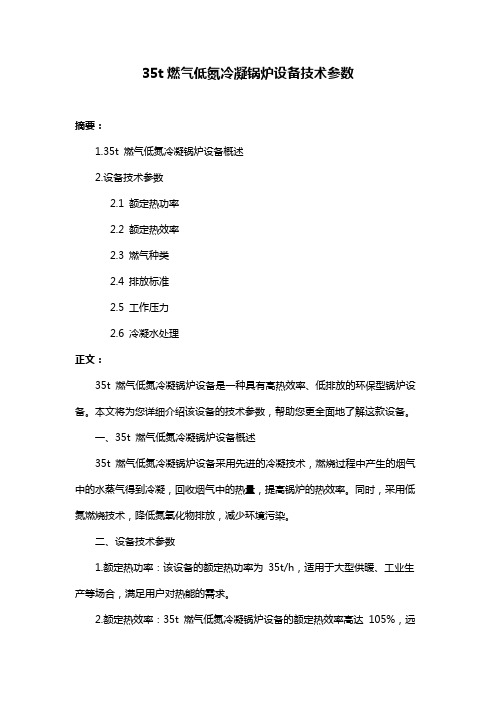
35t燃气低氮冷凝锅炉设备技术参数
摘要:
1.35t 燃气低氮冷凝锅炉设备概述
2.设备技术参数
2.1 额定热功率
2.2 额定热效率
2.3 燃气种类
2.4 排放标准
2.5 工作压力
2.6 冷凝水处理
正文:
35t 燃气低氮冷凝锅炉设备是一种具有高热效率、低排放的环保型锅炉设备。
本文将为您详细介绍该设备的技术参数,帮助您更全面地了解这款设备。
一、35t 燃气低氮冷凝锅炉设备概述
35t 燃气低氮冷凝锅炉设备采用先进的冷凝技术,燃烧过程中产生的烟气中的水蒸气得到冷凝,回收烟气中的热量,提高锅炉的热效率。
同时,采用低氮燃烧技术,降低氮氧化物排放,减少环境污染。
二、设备技术参数
1.额定热功率:该设备的额定热功率为35t/h,适用于大型供暖、工业生产等场合,满足用户对热能的需求。
2.额定热效率:35t 燃气低氮冷凝锅炉设备的额定热效率高达105%,远
高于传统锅炉,节能效果显著。
3.燃气种类:该设备可适用于天然气、液化气等多种燃气,满足不同地区、不同气源的用户需求。
4.排放标准:采用低氮燃烧技术,该设备的氮氧化物排放浓度低于国家规定的排放标准,具有良好的环保性能。
5.工作压力:设备的工作压力为1.0MPa,适用于各种工况条件。
6.冷凝水处理:35t 燃气低氮冷凝锅炉设备设有冷凝水回收系统,对冷凝水进行有效回收和处理,减少环境污染。
总之,35t 燃气低氮冷凝锅炉设备具有高热效率、低排放、环保等优点,是当前锅炉市场上的优质产品。
了解设备的技术参数,有助于我们更好地选择和使用这款设备。
35t燃气低氮冷凝锅炉技术参数
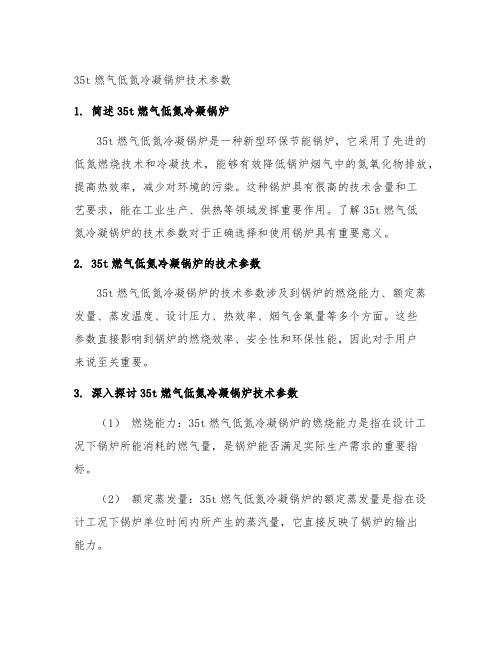
35t燃气低氮冷凝锅炉技术参数1. 简述35t燃气低氮冷凝锅炉35t燃气低氮冷凝锅炉是一种新型环保节能锅炉,它采用了先进的低氮燃烧技术和冷凝技术,能够有效降低锅炉烟气中的氮氧化物排放,提高热效率,减少对环境的污染。
这种锅炉具有很高的技术含量和工艺要求,能在工业生产、供热等领域发挥重要作用。
了解35t燃气低氮冷凝锅炉的技术参数对于正确选择和使用锅炉具有重要意义。
2. 35t燃气低氮冷凝锅炉的技术参数35t燃气低氮冷凝锅炉的技术参数涉及到锅炉的燃烧能力、额定蒸发量、蒸发温度、设计压力、热效率、烟气含氧量等多个方面。
这些参数直接影响到锅炉的燃烧效率、安全性和环保性能,因此对于用户来说至关重要。
3. 深入探讨35t燃气低氮冷凝锅炉技术参数(1)燃烧能力:35t燃气低氮冷凝锅炉的燃烧能力是指在设计工况下锅炉所能消耗的燃气量,是锅炉能否满足实际生产需求的重要指标。
(2)额定蒸发量:35t燃气低氮冷凝锅炉的额定蒸发量是指在设计工况下锅炉单位时间内所产生的蒸汽量,它直接反映了锅炉的输出能力。
(3)蒸发温度:35t燃气低氮冷凝锅炉的蒸发温度是指在锅炉内部产生的蒸汽的温度,它对于蒸汽的质量和用途有着重要的影响。
(4)设计压力:35t燃气低氮冷凝锅炉的设计压力是指锅炉在设计工况下所能承受的最大压力,是保证锅炉安全稳定运行的重要参数。
(5)热效率:35t燃气低氮冷凝锅炉的热效率是指锅炉输出热量与输入燃料热量之比,直接关系到能源利用的效率和节能减排的效果。
(6)烟气含氧量:35t燃气低氮冷凝锅炉的烟气含氧量是指燃烧过程中烟气中氧气的含量,是影响燃烧效率和烟气排放的重要因素。
较低的烟气含氧量通常表示燃烧更加充分,烟气排放更加清洁。
4. 总结35t燃气低氮冷凝锅炉技术参数的重要性35t燃气低氮冷凝锅炉的技术参数直接关系到锅炉的性能和使用效果,正确理解和选取技术参数对于用户来说至关重要。
在选择35t燃气低氮冷凝锅炉时,用户应充分考虑生产工艺和实际需求,全面了解锅炉的技术参数,并在实际使用中严格按照要求进行操作和维护,以确保锅炉的安全稳定运行和良好的节能环保效果。
35t燃气低氮冷凝锅炉技术参数

35t燃气低氮冷凝锅炉技术参数摘要:1.35t 燃气低氮冷凝锅炉简介2.技术参数a.燃气种类b.额定热功率c.额定工作压力d.设计热效率e.排放指标f.冷凝回收率g.结构尺寸3.优势与特点a.低氮排放b.高热效率c.冷凝回收技术d.环保节能4.应用领域a.工业生产b.商业供暖c.居民采暖5.我国政策支持与市场前景1.35t 燃气低氮冷凝锅炉简介35t 燃气低氮冷凝锅炉是一种新型的、环保节能的锅炉设备,采用先进的低氮燃烧技术和冷凝回收技术,具有高热效率、低排放、运行稳定等特点。
该设备适用于工业生产、商业供暖和居民采暖等领域,可满足不同场景的供暖需求。
2.技术参数a.燃气种类:设备可使用天然气、液化石油气等多种燃气。
b.额定热功率:35t,即35 吨/小时,可满足大功率供暖需求。
c.额定工作压力:设备在额定工作压力下运行稳定,保证供暖效果。
d.设计热效率:采用先进技术,热效率高达90% 以上,节能效果显著。
e.排放指标:低氮排放,氮氧化物排放浓度低于国家标准。
f.冷凝回收率:冷凝回收技术可将排放的废气中的热量回收,提高整体热效率。
g.结构尺寸:设备结构紧凑,占地面积小,便于安装和维护。
3.优势与特点a.低氮排放:采用低氮燃烧技术,降低氮氧化物排放,有利于环境保护。
b.高热效率:设备热效率高达90% 以上,节能效果显著,降低运行成本。
c.冷凝回收技术:通过冷凝回收技术,提高整体热效率,进一步降低排放。
d.环保节能:35t 燃气低氮冷凝锅炉在供暖过程中,既保护环境,又节约4.应用领域a.工业生产:为工厂、车间等提供稳定、高效的供暖。
b.商业供暖:适用于商场、办公楼、酒店等商业场所的供暖需求。
c.居民采暖:为居民小区、别墅等提供舒适、安全的供暖。
5.我国政策支持与市场前景我国政府高度重视环境保护和能源节约,对低氮排放、高热效率的锅炉设备给予政策支持。
35t燃气低氮冷凝锅炉技术参数
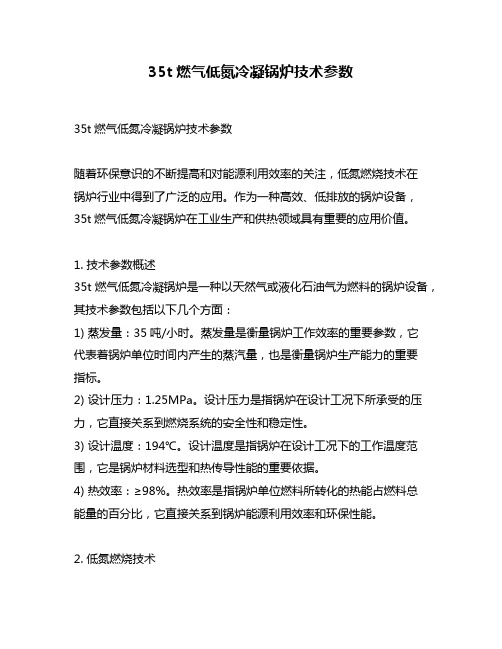
35t燃气低氮冷凝锅炉技术参数35t燃气低氮冷凝锅炉技术参数随着环保意识的不断提高和对能源利用效率的关注,低氮燃烧技术在锅炉行业中得到了广泛的应用。
作为一种高效、低排放的锅炉设备,35t燃气低氮冷凝锅炉在工业生产和供热领域具有重要的应用价值。
1. 技术参数概述35t燃气低氮冷凝锅炉是一种以天然气或液化石油气为燃料的锅炉设备,其技术参数包括以下几个方面:1) 蒸发量:35吨/小时。
蒸发量是衡量锅炉工作效率的重要参数,它代表着锅炉单位时间内产生的蒸汽量,也是衡量锅炉生产能力的重要指标。
2) 设计压力:1.25MPa。
设计压力是指锅炉在设计工况下所承受的压力,它直接关系到燃烧系统的安全性和稳定性。
3) 设计温度:194℃。
设计温度是指锅炉在设计工况下的工作温度范围,它是锅炉材料选型和热传导性能的重要依据。
4) 热效率:≥98%。
热效率是指锅炉单位燃料所转化的热能占燃料总能量的百分比,它直接关系到锅炉能源利用效率和环保性能。
2. 低氮燃烧技术35t燃气低氮冷凝锅炉采用了先进的低氮燃烧技术,通过优化燃烧系统和燃烧控制策略,有效降低了燃烧产生的氮氧化物排放。
低氮燃烧技术主要包括以下几个方面的措施:1) 化学燃烧控制:通过对燃烧空气和燃料的混合比例进行精确控制,实现燃烧过程中氮氧化物的最小生成。
2) 燃烧温度控制:优化燃烧室结构和燃烧温度分布,降低燃烧温度对氮氧化物的生成和释放。
3) 燃烧稳定控制:采用先进的燃烧控制系统和燃烧稳定技术,保证燃烧过程的稳定和均匀,减少氮氧化物的生成。
4) 尾气处理措施:通过烟气脱硝、烟气净化和烟气冷凝等技术手段,进一步降低燃烧排放对环境的影响。
3. 技术优势和应用前景35t燃气低氮冷凝锅炉具有以下几个明显的技术优势和应用前景:1) 高效节能:采用了先进的低氮燃烧技术和冷凝余热利用技术,热效率高达98%,能源利用效率明显优于传统锅炉设备。
2) 低排放环保:低氮燃烧技术有效降低了燃烧排放对环境的影响,氮氧化物排放量大幅减少,符合国家环保政策和标准要求。
35t燃气低氮冷凝锅炉设备技术参数
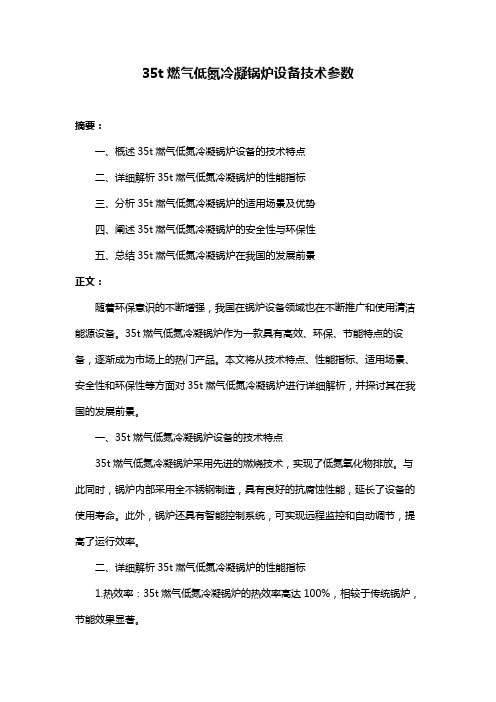
35t燃气低氮冷凝锅炉设备技术参数摘要:一、概述35t燃气低氮冷凝锅炉设备的技术特点二、详细解析35t燃气低氮冷凝锅炉的性能指标三、分析35t燃气低氮冷凝锅炉的适用场景及优势四、阐述35t燃气低氮冷凝锅炉的安全性与环保性五、总结35t燃气低氮冷凝锅炉在我国的发展前景正文:随着环保意识的不断增强,我国在锅炉设备领域也在不断推广和使用清洁能源设备。
35t燃气低氮冷凝锅炉作为一款具有高效、环保、节能特点的设备,逐渐成为市场上的热门产品。
本文将从技术特点、性能指标、适用场景、安全性和环保性等方面对35t燃气低氮冷凝锅炉进行详细解析,并探讨其在我国的发展前景。
一、35t燃气低氮冷凝锅炉设备的技术特点35t燃气低氮冷凝锅炉采用先进的燃烧技术,实现了低氮氧化物排放。
与此同时,锅炉内部采用全不锈钢制造,具有良好的抗腐蚀性能,延长了设备的使用寿命。
此外,锅炉还具有智能控制系统,可实现远程监控和自动调节,提高了运行效率。
二、详细解析35t燃气低氮冷凝锅炉的性能指标1.热效率:35t燃气低氮冷凝锅炉的热效率高达100%,相较于传统锅炉,节能效果显著。
2.排放标准:锅炉氮氧化物排放浓度低于50mg/m,符合我国严格的环保要求。
3.燃料消耗:采用天然气作为燃料,燃料消耗较低,降低了运行成本。
4.噪音:锅炉运行过程中噪音较低,有利于营造良好的工作环境。
三、分析35t燃气低氮冷凝锅炉的适用场景及优势35t燃气低氮冷凝锅炉适用于工厂、酒店、医院、学校等大型场所的热水供应和供暖需求。
相较于传统锅炉,它具有以下优势:1.环保:低氮氧化物排放,有利于改善空气质量。
2.节能:高热效率,降低能源消耗。
3.安全:全自动控制系统,实时监测锅炉运行状态,避免安全隐患。
4.易维护:采用模块化设计,检修保养方便。
四、阐述35t燃气低氮冷凝锅炉的安全性与环保性35t燃气低氮冷凝锅炉在设计过程中充分考虑了安全与环保因素。
锅炉采用先进的安全保护系统,包括熄火保护、过热保护、漏气保护等,确保设备运行安全。
ecoTEC plus VU 豪华型燃气壁挂式冷凝锅炉(系统炉) 技术参数
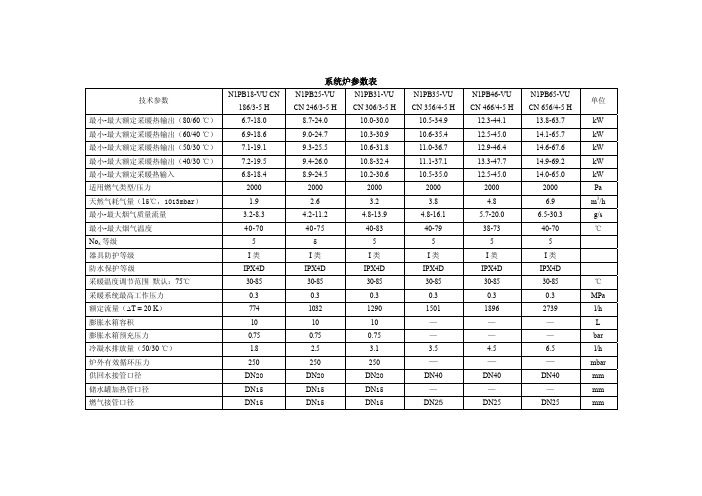
系统炉参数表技术参数N1PB18-VU CN186/3-5 HN1PB25-VUCN 246/3-5 HN1PB31-VUCN 306/3-5 HN1PB35-VUCN 356/4-5 HN1PB46-VUCN 466/4-5 HN1PB65-VUCN 656/4-5 H单位最小-最大额定采暖热输出(80/60 ℃) 6.7-18.0 8.7-24.0 10.0-30.0 10.5-34.9 12.3-44.1 13.8-63.7 kW最小-最大额定采暖热输出(60/40 ℃) 6.9-18.6 9.0-24.7 10.3-30.9 10.6-35.4 12.5-45.0 14.1-65.7 kW最小-最大额定采暖热输出(50/30 ℃)7.1-19.1 9.3-25.5 10.6-31.8 11.0-36.7 12.9-46.4 14.6-67.6 kW最小-最大额定采暖热输出(40/30 ℃)7.2-19.5 9.4-26.0 10.8-32.4 11.1-37.1 13.3-47.7 14.9-69.2 kW最小-最大额定采暖热输入 6.8-18.4 8.9-24.5 10.2-30.6 10.5-35.0 12.5-45.0 14.0-65.0 kW适用燃气类型/压力2000 2000 2000 200020002000Pa天然气耗气量(15℃,1013mbar) 1.9 2.6 3.2 3.8 4.8 6.9 m3/h最小-最大烟气质量流量 3.2-8.3 4.2-11.2 4.8-13.9 4.8-16.1 5.7-20.0 6.5-30.3 g/s最小-最大烟气温度40-70 40-75 40-83 40-79 38-73 40-70 ℃No x等级 5 5 5 5 5 5器具防护等级I类I类I类I类I类I类防水保护等级IPX4D IPX4D IPX4D IPX4D IPX4D IPX4D采暖温度调节范围默认:75℃30-85 30-85 30-85 30-8530-8530-85℃采暖系统最高工作压力0.3 0.3 0.3 0.3 0.3 0.3MPa 额定流量(∆T = 20 K)774 1032 1290 1501 1896 2739 l/h膨胀水箱容积10 10 10 ———L膨胀水箱预充压力0.75 0.75 0.75 ———bar冷凝水排放量(50/30 ℃) 1.8 2.5 3.1 3.5 4.5 6.5 l/h炉外有效循环压力250 250250———mbar供回水接管口径DN20DN20 DN20DN40 DN40 DN40 mm储水罐加热管口径DN15DN15DN15———mm燃气接管口径DN15DN15DN15DN25 DN25 DN25 mm设备重量(净重)35 38 42 41 45 75 kg高度720 720 720 800 800 800 mm宽度440 440 440 480 480 480 mm深度335 335 369 450 450 472 mm电源220~50 220~50 220~50 220~50 220~50 220~50 V/HzA 内置保险 2 2 2 2 2 2最大电功率消耗110 110 140 165 180 260 W。
4吨冷凝式燃气蒸汽锅炉
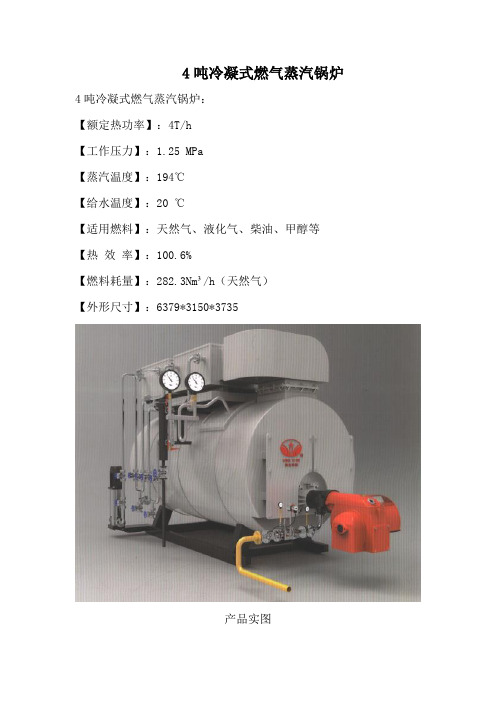
4吨冷凝式燃气蒸汽锅炉4吨冷凝式燃气蒸汽锅炉:【额定热功率】:4T/h【工作压力】:1.25 MPa【蒸汽温度】:194℃【给水温度】:20 ℃【适用燃料】:天然气、液化气、柴油、甲醇等【热效率】:100.6%【燃料耗量】:282.3Nm³/h(天然气)【外形尺寸】:6379*3150*3735产品实图一、产品结构简介1)冷凝器双级布置,烟气余热梯级利用,内部采用无切削挤压螺旋翅片管,强化传热,排烟温度更低,热效率更高。
2)锅炉本体、二级冷凝器、一级冷凝器有机的结合为一体,安装简便易行,占地面积小。
3)根据炉膛辐射换热量和温度的四次方成正比的原理,我们优化了受热面的设计,波形炉胆总吸热量比例较大,具有良好的胀缩性。
4)轴对称向下偏置,湿背式顺流燃烧二回程结构,高温烟气全部聚集在前烟箱,后部烟温很低,直接用保温层保温,降低了维护费用;整体式前烟箱双开门设置,烟箱门双层密封,结构简单,便于开启、运行、操作和维护。
5)本锅炉采用硅酸铝、离心玻璃棉作为保温材料,其保温性能好、重量轻、运输安装方便。
6)锅炉上部设有人孔装置,下部设有清洗装置,便于维护和保养。
7)本系列锅炉的制造按GB/T16508.4-2013《锅壳锅炉第4部分:制造、检验与验收》的要求执行,完全符号国家标准。
二、配套辅机参数1)燃烧器根据烟风阻力计算,特选以下燃油燃气燃烧器,从燃烧器的“负荷图”性能曲线中得出背压数值,据此可知,该燃烧器能确保锅炉安全、有效地运行。
2)给水泵依据本炉型的蒸发量、额定工作压力,选配的“利欧泵”,是目前工业发达国家普遍用于工业锅炉给水的优质产品,具有体积小、重量轻、效率高、节能、振动噪音小、运转平稳、使用寿命长的特点。
产品实图 三、锅炉主要附件四、电器控制WNS4-1.25-Y、Q炉采用PLC自动控制系统。
该控制系统以PLC作为控制和数据采集核心,输入压力控制器的超压保护信号,水位传感器的水位控制检测信号、极低水位检测电极信号、超高水位检测电极信号,给水泵的电机保护检测信号,压力变送器控制燃烧器的各个信号及超压保护信号,使之具有丰富的人工智能,最大限度的保证了锅炉的安全可靠运行。
燃气冷凝式模块锅炉

客户对燃气冷凝式模块锅炉的需求主要集中在高效、环保、安全等方面。同时,对于产品 的智能化、定制化等也有较高要求。
未来发展趋势预测与机遇挑战
1
发展趋势
随着科技的不断进步和环保政策的持续 加强,燃气冷凝式模块锅炉将向更高效 、更环保、更智能的方向发展。例如, 采用先进的燃烧技术、优化热交换器设 计、提高余热回收效率等。
选型计算
设计锅炉房布局、烟风系统、水系统、控制 系统等。
系统设计
根据需求进行选型计算,确定锅炉型号、数 量及配置。
施工图纸
绘制锅炉房平面布置图、系统流程图、设备 安装图等。
关键参数计算与选型依据
01
热负荷计算
根据建筑物供暖、通风、空调等需 求计算热负荷。
燃料消耗量计算
根据锅炉热效率及燃料低位发热量 计算燃料消耗量。
燃气冷凝式模块锅炉
汇报人:停云 2024-01-16
目录
• 燃气冷凝式模块锅炉概述 • 燃气冷凝式模块锅炉结构与组成 • 燃气冷凝式模块锅炉性能特点 • 燃气冷凝式模块锅炉选型与设计 • 燃气冷凝式模块锅炉安装与调试 • 燃气冷凝式模块锅炉运行与维护 • 燃气冷凝式模块锅炉市场前景与发展趋势
01
应用领域与市场需求
应用领域
燃气冷凝式模块锅炉广泛应用于家庭、学校、医院、办公楼等需要供暖的场所。它可以作为独立的供暖设备使用 ,也可以与其他供暖设备配合使用,构成集中供暖系统。
市场需求
随着人们生活水平的提高和环保意识的增强,对于供暖设备的需求也越来越高。燃气冷凝式模块锅炉作为一种高 效、环保的供暖设备,具有很大的市场需求。同时,随着国家对于节能减排政策的不断加强,燃气冷凝式模块锅 炉的市场前景更加广阔。
排烟不畅
水冷全预混全冷凝超低氮烧锅炉介绍

水冷全预混全冷凝超低氮烧锅炉介绍概述水冷全预混全冷凝超低氮烧锅炉是一种高效、节能、环保的燃气锅炉。
其主要特点在于采用全预混燃烧技术和全自动控制技术,同时利用全水冷壁和全冷凝烟气换热技术,大大提高了能量利用效率,减少了二氧化碳等有害气体的排放,适用于多种工业和民用场合。
技术原理水冷全预混全冷凝超低氮烧锅炉主要由燃烧系统、水冷系统、烟道系统和控制系统四部分组成。
其中燃烧系统采用全预混燃烧技术,将燃气和空气预先混合,然后经过均匀分布的喷嘴燃烧,热量通过全水冷壁吸收后传递给水,再通过全冷凝烟气换热器冷凝回收,最终形成超低氮排放的烟气。
水冷系统采用全水冷壁技术,即燃烧室内所有表面都与循环水接触,有效地控制了燃烧室壁面温度,在提高燃烧效率的同时延长了燃烧室使用寿命。
烟道系统采用全冷凝烟气换热器技术,即将烟气在烟道内部冷凝回收,提高了烟气的回收利用率,实现了零排放。
控制系统采用全自动控制技术,通过传感器和计算机控制各部分的工作状态,实现了系统的智能化和稳定性。
特点和优势水冷全预混全冷凝超低氮烧锅炉具有以下特点和优势:1.高效节能:采用全预混燃烧技术、全水冷壁和全冷凝烟气换热技术,能源利用效率高达97%以上,大大降低了燃料消耗和能源成本。
2.环保节能:采用超低氮燃烧技术和全冷凝烟气换热技术,将氮氧化物排放降至20mg/m³以下,烟气排放无污染物。
3.使用寿命长:采用全水冷壁技术,控制了燃烧室壁面温度,延长了燃烧室使用寿命。
4.全自动控制:采用全自动控制技术,稳定可靠,无人值守。
5.应用广泛:适用于各种工业和民用场合,如造纸、化工、食品、医药等行业的蒸汽供应和城市供暖等。
应用案例水冷全预混全冷凝超低氮烧锅炉已经在多个行业和领域得到广泛应用。
以下是其中一个应用案例:上海某热电联产厂2019年采购6台产品,用于电站火电锅炉的控制系统升级。
根据使用情况反馈,全预混燃烧技术和全冷凝烟气换热技术,比传统燃烧方式节能33.6%以上。
一体式冷凝燃气锅炉产品特点及参数
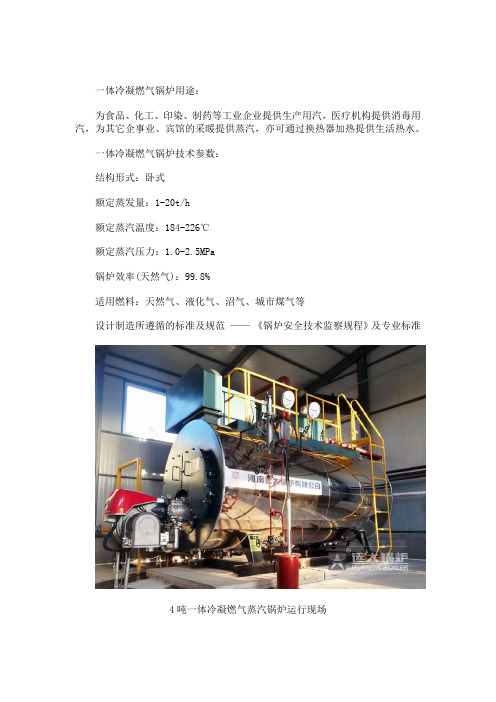
一体冷凝燃气锅炉用途:
为食品、化工、印染、制药等工业企业提供生产用汽,医疗机构提供消毒用汽,为其它企事业、宾馆的采暖提供蒸汽,亦可通过换热器加热提供生活热水。
一体冷凝燃气锅炉技术参数:
结构形式:卧式
额定蒸发量:1-20t/h
额定蒸汽温度:184-226℃
额定蒸汽压力:1.0-2.5MPa
锅炉效率(天然气):99.8%
适用燃料:天然气、液化气、沼气、城市煤气等
设计制造所遵循的标准及规范——《锅炉安全技术监察规程》及专业标准
4吨一体冷凝燃气蒸汽锅炉运行现场
WNS系列冷凝燃气锅炉产品特点:
1、该系列锅炉一体组合式设计,锅炉本体、节能器、冷凝器一体组合,节能空间;节能器加冷凝器双极节能,热效率高达99.8%。
2、整个锅炉系统是由锅炉本体、各级余热回收、控制阀、节能水箱和控制系统等几部分紧密结合的有机整体,各部件间配置合理,统一协调;
3、炉胆采用波纹炉胆结构,既增加了辐射和对流传热面积,又满足了炉胆受高温辐射后自由膨胀的需要。
4、低阻高效的螺纹管代替传统的光管以强化传热,提高热效率。
5、前烟箱门与面板采用双层密封结构,优质保温材料,保证良好的密封和保温性能。
6、配置可拆式弹簧防爆门,保证安全运行安全,同时也可用作炉膛检查孔。
7、采用差压式检测、变频连续给水系统,使锅炉运行更加稳定,提升锅炉运行效率。
7、烟气余热回收部分采用了高效钢铝复合螺旋趐片管换热,换热面充足,烟气侧系统阻力小,满足一般燃烧机的要求。
威能Vitocrossal 200燃气冷凝锅炉技术数据手册说明书

Technical Data ManualVITOCROSSAL200Gas-fired Condensing Boiler1445 to 2245 MBH (423 to 658 kW)Model Nos. and pricing : See Price ListVitocrossal 200CM2 Series 400, 500, 620 and 620 TXHigh efficiency, gas-fired condensing boilerwith pre-mix modulating cylinder burnerfor natural gas or liquid propane gas with Inox-Crossal heatexchanger made of high-grade SA 240-316 Ti stainless steel.For operation without low limit on boiler return watertemperature.For closed loop hot water heating systems with maximumsupply water temperatures of 210° F (99° C) for amaximum operating pressure of 75 psig.Heating input: 1445 to 2245 MBH(423 to 658 kW)Product may not be exactly as illustrated.H73 596 - 03Benefits at a glance:Inox-Crossal heat exchanger surface made of high- grade SA 240-316 Ti stainless steel for high operational reliability and long service life. - Easy dispersal of condensate through vertical gas flues; therefore no concentration of condensate. - Increased self-cleaning effect through smoothstainless steel surfaces.Highly efficient heat transfer and high condensation rate through - highly turbulent flow of flue gas through the heat exchanger.- boiler water and hot gases flowing in counter flow.Efficiency up to 98% through intensive condensation. The flue gas temperature is only approximately 9-27° F (5 - 15° C) above boiler return temperature (see chart below).Clean combustion - through perfect match of burner and boiler, low combustion chamber loading andstraight-through combustion chamber.Easy handling in boiler rooms through particularly lowbuild height and weight.Easy installation and elimination of wiring mistakeswith Viessmann pre-wired plug-in system.Heating boiler, heating system control, domestic hot water storage tank and all other Viessmann system technology components are coordinated to one another. All components are design-matched for quick installation.Pre-mix cylinder burner for environmentally-friendly operation with a modulation range from 20 to 100%.All hydronic connections can be fitted from above.Economical and safe heating system operation through Vitotronic digital control system with communication capability. Tailored to every need, covering all known control strategies and applications. Standard LON BUS for complete integration intobuilding management systems.Particularly quiet operation.High altitude operation up to 10,000 ft. (3000 m) with a simple electronic adjustment.Vitocrossal 200 boiler efficiency dependent on system heating water return temperatures and load conditionsB o i l e r E f f i c i e n c y i n %System Partial Load in %DesignSupply / Return104° F - 88° F (40° C - 30° C)Curve 0.5DesignSupply / Return 167° F - 140° F (75° C - 60° C)Curve 1.4DesignSupply / Return 194° F / 158° F (90° C - 70° C)Curve 1.8Outdoor TemperatureB o i l e r W a t e r / S u p p l y T e m p e r a t u r eRoom Set-Point Temperature73 596 - 03LegendA Supply/return temperature of 176/140° F (80/60° C)B Supply/return temperature of 158/122° F (70/50° C)C Supply/return temperature of 140/104° F (60/40° C)D Supply/return temperature of 122/86° F (50/30° C)E Supply/return temperature of 104/68°F (40/20° C)Flue gas temperature as a function of average partial load firings.73 596 - 03LegendA Stainless steel Inox-Crossal heat exchangerB Highly effective thermal insulationC Water-cooled stainless steel combustion chamberD Wide water passageways - good natural circulationE Modulating MatriX cylinder burner73 596 - 03Boiler Model CM2400500620620 TX InputMBH 1445180022451999*3(kW)(423)(527)(658)(585)Minimum Input NG MBH 287358450450(kW)(84)(105)(132)(132)Minimum Input LPG MBH 351440545545(kW)(103)(129)(160)(160)Output *1MBH (kW)1372(402)1710(501)2132(625)1899*2(556)Net AHRI ratingMBH (kW)1193(350)1487(436)1854(543)1651(484)Combustion efficiency *1%95.195.195.195.1*2Thermal efficiency *1%95.095.095.095.0*2Overall length(e)in.89b 955/81007/81007/8(mm)(2273)(2429)(2562)(2562)Overall width (c)in.423/8423/8443/8443/8(including insulation)(mm)(1078)(1078)(1128)(1128)Overall height (a)in.655/8655/868c 68c (including control unit)*4(mm)(1666)(1666)(1748)(1748)Concrete boiler base Lengthin.465/8535858(mm)(1185)(1345)(1475)(1475)Widthin.42.542.544.544.5(mm)(1245)(1245)(1295)(1295)Thickness in.4444(mm)(100)(100)(100)(100)Weight Boiler bodylb 1136125714881488(Kg)(515)(570)(675)(675)Complete with the burner, control lb 1495166219291929and thermal insulation(Kg)(678)(754)(875)(875)*1 Tested to U.S. Standards ANSI Z21.13/CSA 4.9 and AHRI, BTS-2000 Testing Standard Method to determine the efficiency of Commercial Heating Boilers.*2 T ested to U.S. Standards ANSI Z21.13/CSA 4.9.*3 Boilers with this maximum input rating is only offered in the USA.*4 A dd 1f in. (40 mm) when using seismic mounts (optional accessory).Note: For altitude operation up to 4,999 feet, derate the input capacity by 3%/1000 ft. For operation from 5,000 to 10,000 feet, with the electronic altitude adjustment made, derate the input capacity by an additional 0.6%/1000 ft. for a total derate of 18%.AA Input capacity after electronic altitude adjustment is made.73 596 - 03Boiler ModelCM2400500620620 TX Boiler Water ContentUSG 104112131131(L)(395)(425)(495)(495)Heat exchanger surface ft.2166.6208.6234234water cooled(m 2)(15.5)(19.4)(21.7)(21.7)Maximum Operating Temperature °F (°C)210 (99)210 (99)210 (99)210 (99)Maximum Adjustable High Limit °F (°C)203 (95)203 (95)203 (95)203 (95)Maximum Operating Pressure psig 75757575(bar)(5)(5)(5)(5)Boiler ConnectionsBoiler supply and return (BS), (BR)in.4444(ANSI flanges)(mm)(100)(100)(100)(100)Safety Supply in.1a 1a 1a 1a Boiler Drainin.1b1b1b1bCondensate Drain in.¾¾¾¾Vent pipeInternal Diameterin.10101010(mm)(252)(252)(252)(252)Flue Gas Valuestemperature (at a returntemperature of 86° F (30° C)at rated input °F 113113113113(°C)(45)(45)(45)(45)at partial load°F 86868686(°C)(30)(30)(30)(30)Temperature (at a returntemperature of 140° F (60° C)at rated input°F 167167167167(°C)(75)(75)(75)(75)Mass flow rate (of flue gas)at rated inputlbs/h 1276158719861767(kg/h)(579)(720)(901)(802)at partial loadlbs/h 255317399399(kg/h)(116)(144)(181)(181)Pressureat boiler flue outlet pa 70707070at rated input “w.c.0.280.280.280.28Standby lossat maximun input and steady state condition 180° F/80° F (82° C/27° C) supply and return water temperatureBTU/h (W)%1878 (550)0.132520 (738)0.143367 (986)0.153367 (986)0.15At boiler water temperature 158° F (70° C) [roomtemperature 68° F (20° C)]BTU/h (W)%4335 (1270)0.35400 (1580)0.36735 (1973)0.36735 (1973)0.373 596 - 03LegendA Boiler LengthB Boiler WidthC Boiler Height AGA Flue outletBO Inspection Opening (Canada only)E DrainKOA Condensate drainKTS Boiler water temperature sensor KR Boiler return KV Boiler flowRG Female connection R b for additional control equipment (e.g. fitting assembly with minimum and maximum pressure switch)SA safety connection (safety valve)STB Flue outletDimensions Model CM2400500620620 TX a*in. (mm)655/8 (1666)655/8 (1666)68c (1748)68c (1748)b*in. (mm)56a (1428)56a (1428)59b (1511)59b (1511)c in. (mm)423/8 (1078)423/8 (1078)443/8 (1128)443/8 (1128)d=B in. (mm)35c (910)35c (910)37c (960)37c (960)e in. (mm) 89b (2273)955/8 (2429)1007/8 (2562)1007/8 (2562)f in. (mm)85a (2163)85a (2319)96c (2455)96c (2455)g in. (mm)46c (1187)527/8 (1343)58a(1477)58a (1477)h=A in. (mm) 59 (1497)65 (1650)703/8 (1787)703/8 (1787)i in. (mm)217/8 (555)28c (713)33b (851)33b (851)j=BO in. (mm) 4 (101) 4 (101) 4 (101) 4 (101)k in. (mm) 34a (870)34a (870)345/8 (879)345/8 (879)l in. (mm)15d (383)12c (435)187/8 (480)187/8 (480)m in. (mm) 10 (254)12d (308)13c (351)13c (351)n in. (mm)12b (318)145/8 (370)163/8(415)163/8(415)o in. (mm) 2c (70)2c (70)25/8 (67)25/8 (67)p*in. (mm)277/8 (708)277/8 (708)29 (736)29 (736)q*in. (mm)53b (1360)545/8 (1387)57b (1460)57b (1460)r=C*in. (mm)583/8 (1482)593/8 (1509)62a (1582)62a (1582)s in. (mm)23c (601)23c (601)23c (601)23c (601)t*in. (mm)9 (229)9 (229)9 (229)9 (229)u*in. (mm) 57/8 (149) 57/8 (149)57/8 (149)57/8 (149)vin. (mm)5a (133)5a (133)5a (133)5a (133)* Add 1f in. (40 mm) when using seismic mounts (optional accessory).73 596 - 03Mechanical roomotherwise the system may suffer faults and damage. In rooms where air contamination from halogenated hydrocarbons is to be expected, operate the boiler only in balanced flue mode.Minimum clearances to combustibles Boiler model CM2400500620620 TXTop 0Sides 0Flue As per vent manufacturer’s specificationsFront 0FloorcombustibleLegend A Boiler B Burner*1 Clearance may be reduced to zero in multi-boiler installations, provided the side panel removal is not required.Note: The burner, boiler control, condensate trap, venting and heat exchanger are still fully accessible from the front and rear of the boiler.*2 Clearance for vent pipe installation.To enable convenient installation and maintenance, observe the stated clearance dimensions. Maintain the minimum clearances where space is tight.In the delivered condition, the boiler door hinge bracket is factory installed on the left side of the door. If required, the boiler door hinge bracket can be reinstalled on the right side of the door. CM2400500620/620 TX a *1 in. (mm)20 (500)20 (500)20 (500)b *2 in. (mm)30 (760)30 (760)30 (760)c in. (mm)20 (500)20 (500)20 (500)d in. (mm)20 (500)20 (500)20 (500)e in. (mm)24 (600)24 (600)24 (600)f in. (mm)11 (280)11 (280)11 (280)g in. (mm)15b (395)15b (395)15b (395)73 596 - 03Pressure drop (primary circuit)The Vitocrossal 200 is only suitable for fully pumped hot water heating systems.Recommended Flow Rates CM2Boiler model 400500620620 TX 20° F ❒t GPM 137.2171.0213.2198.940° F ❒t GPM 68.685.5106.695.011° C ❒t m 3/h 31.138.848.443.222° C ❒tm 3/h15.519.424.221.6❒t = temperature differenceThis boiler does not require a flow switch.P r e s s u r e dr o pFlow rate73 596 - 03Specifications Boiler Model CM2400500620620 TX Voltage V 120120120120FrequencyHz60606060Power consumption NG at max. input W 540700900801at min. inputW54606060Power consumption LPG at max. input W 467590700623at min. input W59686060Version modulatingDimensionsLength in. (mm)385/8 (980)385/8 (980)41¾ (1060)41¾ (1060)Widthin. (mm)26 (661)265/8 (675)265/8 (675)265/8 (675)Height in. (mm)21a (540)205/8 (525)24b (622)24b (622)Weight Burner onlyBurner package (with kits, flanges and mounting hardware)lb. (kg)lb. (kg)75 (34)91 (41.3)90 (41)90 (41)93 (42)93 (42)93 (42)93 (42)Min. gas supply pressure Natural gas “w.c.4444Liquid propane gas “w.c.10101010Max. gas supply pressure Natural gas “w.c.14141414Liquid propane gas “w.c.14141414Gas connectionNPT1a1a1a1a115773 596 - 03CM2 pre-mix cylinder burner 400/500/620/620 TXLegendA Burner frameB Air pressure switch 1C Air pressure switch 2D Display and programming unitE Gas valveF Gas supply pipeG Gas pressure switchH Rotary damper with servomotor (400, 620 and 620 TX only)I Gas pipeJ Manual shut-off valve K Venturi mixing pipe L Gas fanM Burner gauze assembly N Ignition electrodes O Ionization electrode P Ignition unitQBurner control unitR Mains filter unit with contactorCM2 Boiler model 400500620620 TX a in. (mm)20 (506)20 (506)20 (506)20 (506)b in. (mm)385/8 (980)385/8 (980)41c (1060)41c (1060)c in. (mm)26 (661)265/8 (675)265/8 (675)265/8 (675)din. (mm)21a (540)20f (525)24b (622)24b (622)125773 596 - 03Installation fittings for standard equipment includes:- low water cut-off- safety header (c/w 75 psig pressure relief valve, air vent and pressure gage)- drain valve - product documentation - combustion air intake kit - NG to LPG conversion kitVitotronic 300 (type GW5B) and LON module for modulating boiler water temperature for eachboiler of the multi-boiler system and Vitotronic 300 (type GW5B) and LON module for modulating boiler water temperature inconjunction with an external control unit (BMS). Vitocontrol-S, CM2 control panelwith Vitotronic (300-K, type MW1B) for multi-boiler system, outdoor reset mode and mixing valve control for a m aximum of 2 heating circuits with mixing valve and additional Vitotronic 200-H, type HK1B for 1heating circuit with mixing valve.For single boiler systemsVitotronic 300 (type GW5B)Outdoor reset control for stand alone operation, for modulating water temperature with mixing valve(optional expansion board for two additional circuits).CM2 Boiler model 400500620620 TX Thermal insulation 2222Cylinder burner1111Boiler control unit (see boiler control alternatives below)1111Boiler coding card 1111Technical documentation 2222Combustion air intake kit 1111Junction box1111Boiler body with fitted mating ANSI flanges and gaskets to all connectors and fitted protective crate, plus flue gas collector collar.For single-boiler or multiple-boiler installationsCustom control panels for residential or commercialapplications are designed and manufactured by Viessmann to suit any customer’s specific requirements. Customcontrol panels can integrate features such as pool heating, hot tub heating, snow melting, telephone tie-in, integration with Building Management Systems, as wellas several other functions. Please inquire.Refer to the common venting flue vent damper Installation Instructions.- Motorized flue gas damper (for cascade venting system)135773 596 - 03Note: The ‘amount of condensate” and the “flue gas temperature gross” graphs are independent of each other.Condensate and its disposalDuring the operation of the boiler, the amount ofcondensate to be expected can be read from the above diagram.The values given are approximate amounts occurring under practical conditions. Not included in the diagram is the amount of condensate occurring in the vent pipe and chimney system. The condensate from the chimney system can be collected together with the condensate from the heating boiler and be disposed of into a floor drain. The condensate will be between 3 and 4 on the pH scale. If local building requirements demand neutralizing the condensate before disposal, contact Viessmann Manufacturing Company Inc. for a correctly sized neutralization tank. The treated condensate will show pH values of between 6.5 and 9 and can then be disposed of into the waste water system.Design notes regarding draining condensateThe condensate drain to the sewer connection must be able to be inspected.Route it with a gradient and equip the pipe with a P-trap; also provide suitable facilities for taking samples.The bottom drain should be located below the anti-flooding level of the flue gas collector box.Condensate drains must only be made from corrosion resistant materials (e.g. fibre reinforced hoses). Never use any galvanized materials or those containing copper or black iron for pipes, connectors, etc.Install a P-trap in the condensate drain to prevent flue gases from escaping.Venting optionsPP(s) (Polypropylene) flue gas/fresh air system for room air independent operation (sealed combustion), and PP(s) flue gas for room air dependent operation are tested to ANSI Z21.13 - CSA 4.9 - 2000 standards and are certified together with the Vitocrossal 200 boiler as a constructional unit.The Vitocrossal 200 boiler may also be vented using an special stainless steel, single-wall, (UL listed for category IV).The boiler may be vented horizontally through the side wall or vertically through the roof.For a more detailed description of the direct vent and single-wall vent system, please refer to the Vitocrossal 200 Installation Instructions venting section.Use ULC S-636 / UL 1738 certified for category IV boilers. The following vent system suppliers may be contacted for assistance in designing the appropriate PP(s) venting system for Vitocrossal 200 CM2 boilers.M&G / Duravent Tel. 800-835-4429Tel. 518-649-9700Fax: 518-463-5271Email:******************Web: Centrotherm InnoFlue Eco Systems. L.L.C.Tel. (877) 434-3432Fax. (518) 618-3166Email:*******************.com Web: A m o u n t o f c o n d e n s a t eBoiler water return temperatureF l u e g a s t e m p e r a t u r e g r o s sF l u e g a s t e m p .a t f u l l i n p u ta t pa r t i a l l o ad F l ue g a s t e m p .A m o u n t o f c on d e n s a t e Ensure that the domestic drainage systems are madefrom materials which are resistant to acidic condensatesuch as:Burner adjustmentMartix cylinder burner tested at operating temperature and adjusted in the factory.145773 596 - 03System layoutThe boiler water temperature limit is factory set to 167° F (75° C).The boiler water temperature limit can be increased by altering the adjustable high limit (AHL) to increase the supply water temperature.To minimize piping losses of the system, however,Viessmann recommends that the radiation and domestic hot water production in the system be designed for a 158° F (70° C) boiler supply water temperature.WarrantyOur warranty does not cover damages resulting from the following:- Operation with contaminated fill and supplementary feed water- Operation with contaminated combustion air- Exposing the boiler to pressures and temperatures higher than its certified rating See warranty sheet for details.Use ULC S-636 / UL 1738 certified venting systems for category IV boilers. The following vent system suppliers may be contacted for assistance in designing theappropriate stainless steel venting system for Vitocrossal 200 CM2 boilers.Combustion air supplyThe boiler must not be located in areas or rooms where chemicals containing chlorine, bromine, fluorine, or other corrosive chemicals are stored. Examples include bleach, refrigerants, paint, paint thinner, hair spray, cleaning solvents, water softener salt, etc. The combustion air must not be contaminated with any amount of the above mentioned chemicals.Boiler should never be installed in areas where excessive dust, high humidity, or risk of frost exist. Ensure adequate ventilation and supply of fresh combustion air.Consult your local Viessmann sales representative with uncertainties in regard to a suitable boiler installation location.This boiler/burner unit needs clean fresh air for safe operation. Provisions for combustion and ventilation air must be made at time of installation. For gas or propane installations, use the “Natural Gas Installation Code CAN/CSA-B149.1 or B149.2” (Canada), or “National Fuel Gas Code ANSI Z223.1” (USA), and/or provisions of local codes.The sizing methods outlined in the aforementioned codes should be used when installing a round duct to supply combustion air from the outside.M&G / Duravent Tel. 800-835-4429Tel. 518-649-9700Fax: 518-463-5271Email:******************Web: ICC - Industrial Chimney Co.400 J-F Kennedy,St-Jerome, Quebec Canada, J7Y 4B7Tel. 514-565-6336Fax: 514-565-6519Email:*****************Selkirk Canada Corporation 375 Green RoadStoney Creek, ON L8E 4A5Tel.: (905) 662-6600Fax: (905) 662-5352(US) 1-800-992-8368(Canada) 1-888-735-5475Email:********************Web: Novaflex1-20 East Pearce St.,Richmond Hill, Ontario,Canada, L4B 1B7Tel. 905-731-9411Email:********************Wesmech Technical Sales 50 Ronson Drive, Suite 160Toronto, ON M9W 1B3Tel.: (416) 251-8990Fax: (416) 251-89001-800-613-3789Email:********************Web: Van-Packer Co. Inc.302 Mill Street PO Box 307Buda, IL 61314Tel.: (309) 895-2311Fax: (309) 895-38911-888-877-8225Email:*******************Web: Security Chimneys International Ltd.2125 Rue Monterey, Laval, Quebec H7L 3T6Tel. 450-973-9999(US) 1-800-361-4909(Canada) 1-800-667-3387Fax: 450-973-2222Email: infoeng@Web: Enervex Inc.(formerly Exhausto)Tel: 770-587-3238Fax: 770-587-4731(800) 225-2923Email:*****************Web:Centrotherm InnoFlue Eco Systems. L.L.C.Tel. (877) 434-3432Fax. (518) 618-3166Email:*******************.com Web: 155773 596 - 03Airborne noise attenuationFrequently, modern boilers are equipped with silencer hoods or sound insulated ventilation air inlet housings.For larger systems, it may be necessary to route theventilation air through a sound-insulated channel, in order to avoid a noise nuisance outside the building.Flue gas silencers are generally only required where higher noise protection measures are called for. Whether or not a flue gas silencer is required can be predicted only with some difficulties, because of the complexity of the creation and propagation of flame noise, the interaction between the burner, boiler and the flue gas system as well as the operating mode (flue gas system operating with positive or negative pressure).It is advisable, therefore, to assess the noise emission into the neighborhood and to consider the sound pressure level measured at the flue gas system outlet. It should beconsidered at the planning stage whether silencers might become necessary later.In planning for its possible use, it is important thatsufficient space for the flue gas silencer is available behind the boiler. Good engineering practice mandates that the exhaust pressure drop of the silencer be included in the vent size calculation.Anti-vibration measuresAnti-vibration supports can be field supplied as an economical and effective solution to combat noise generated.When sizing such supports, take the entire operating weight of the boiler system and, when using longitudinal anti-vibration brackets, the condition of the supporting surface into consideration.Effective anti-vibration measures are particularly important when installing boilers into an attic. Flexible couplings may be used to physically separate the combustion equipment from the building.These should be installed into the boiler flow, return and safety pipe and as near as possible to the boiler.Also insulate any braces or hanging arrangements, if installed, against sound/vibration transmission to the building.Water qualityTreatment for boiler feed water should be considered in areas with known problems, such as where a high mineral content and hardness exist. In areas wherefreezing might occur, it recommended that an antifreeze be added to the system water for protection againstfreezing. Please adhere to the specifications given by the antifreeze manufacturer. Do not use automotive silicate-based antifreeze. Please observe that an antifreeze/water mixture may require a back flow preventer within the automatic water feed and influence components such as diaphragm expansion tanks, radiation, etc. A 40% antifreeze content will provide freeze-upprotection to -10° F (-23° C). Do not exceed 50%antifreeze mix ratio and do not use antifreeze other than specifically made for hot water heating systems. Oxygen diffusion barrier under floor tubingThe boiler warranty does not cover pressure vessel failure resulting from corrosion caused by the use of underfloor plastic tubing without an oxygen diffusion barrier. Such systems without oxygen diffusion barrier must have the tubing separated from the boiler with a heat exchanger. Viessmann always recommends the use of underfloor plastic tubing with an oxygen diffusion barrier.Boiler/burner start-upVitocrossal 200, CM2 boilers with Viessmann cylinder burners does not require start-up by Viessmann. Sound attenuationPlease consult a professional engineer who is specialized in noise attenuation for advice.The burner/boiler systems, circulation pumps and other auxiliary equipment used in heating systems generate noise.This noise is transferred from the boiler room viafloorboards, ceiling and walls to neighboring rooms and via the flue gas system as well as the ventilation air and exhaust air apertures into other rooms and into the open, where they may cause a nuisance.To avoid this from happening, additional protective measures may be required which should be considered at the design stage.Subsequent measures to reduce noise nuisance frequently require extensive effort and expenditure.Total output (MBH)Total Hardness (ppm as ca CO 3)> 1 Total 680 200> 680 to 2050150The pH value of the heating water should be between 8.2 and 9.55773 596 - 03 T e c h n i c a l i n f o r m a t i o n s u b j e c t t o c h a n g e w i t h o u t n o t i c e.P r i n t e d o n e n v i r o n m e n t a l l y f r i e n d l y (r e c y c l e d a n d r e c y c l a b l e ) p a p e r.。
全预混冷凝燃气锅炉

全预混冷凝燃气锅炉简介全预混冷凝燃气锅炉是一种高效、环保的供暖设备,采用全预混燃烧技术和冷凝回收技术,能够充分利用燃气热能,在保证供热质量的同时降低燃气消耗,减少有害气体排放。
本文将对全预混冷凝燃气锅炉的工作原理、特点以及应用领域进行详细介绍。
一、工作原理全预混冷凝燃气锅炉以燃气为燃料,通过分离燃气和空气,然后进行充分混合,使燃气完全燃烧。
在燃烧过程中,产生的烟气通过特殊的烟气换热器,在较低的温度下冷凝排出。
在全预混燃烧过程中,燃气和空气以适当的比例混合,形成能够燃烧的预混合气体。
这种预混合气体将进一步混合均匀,以保证充分的燃烧效果和高效的热能转化。
通过冷凝回收技术,全预混冷凝燃气锅炉将烟气在烟气换热器中降低温度,使烟气中的水蒸气冷凝成水,并释放出潜热。
这样不仅提高了热能利用效率,还减少了烟气中的有害气体排放。
二、特点1. 高效节能:采用全预混燃烧技术,燃料充分燃烧,热能转化效率高,比传统锅炉节能30%以上。
同时,利用冷凝回收技术,能够回收烟气中的热能,进一步提高能源利用效率。
2. 低排放:全预混冷凝燃气锅炉在燃烧过程中,由于燃料充分燃烧,减少了燃料中的不完全燃烧物质的产生,从而减少了有害气体的排放。
冷凝回收技术还能够降低烟气温度,使其中的水蒸气冷凝成水,减少了水蒸气中的一氧化碳和氮氧化物的排放。
3. 温控精准:全预混冷凝燃气锅炉配备了先进的控制系统,能够实时监测室内温度和室外温度,并根据需求自动调节供热温度,保证室内温度的稳定及舒适。
4. 超静音设计:全预混冷凝燃气锅炉在设计上注重降噪,使用静音技术,减少了锅炉运行时的噪音,保证了居室的静谧。
5. 安全可靠:全预混冷凝燃气锅炉配备了多重安全保护措施,如气体泄漏报警、过热保护等,确保锅炉的安全可靠运行。
三、应用领域全预混冷凝燃气锅炉适用于各种供暖场合,如家庭供暖、商业办公楼供暖、工业厂房采暖等。
由于其高效节能和低排放的特性,被广泛应用于新建建筑和改造项目中。
低氮冷凝燃气锅炉工作原理
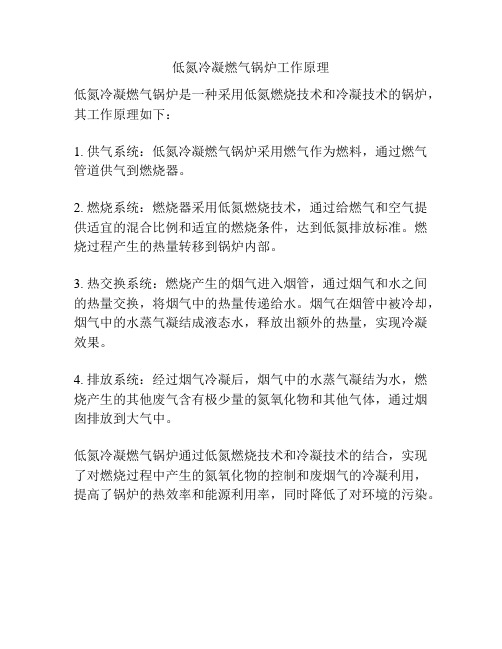
低氮冷凝燃气锅炉工作原理
低氮冷凝燃气锅炉是一种采用低氮燃烧技术和冷凝技术的锅炉,其工作原理如下:
1. 供气系统:低氮冷凝燃气锅炉采用燃气作为燃料,通过燃气管道供气到燃烧器。
2. 燃烧系统:燃烧器采用低氮燃烧技术,通过给燃气和空气提供适宜的混合比例和适宜的燃烧条件,达到低氮排放标准。
燃烧过程产生的热量转移到锅炉内部。
3. 热交换系统:燃烧产生的烟气进入烟管,通过烟气和水之间的热量交换,将烟气中的热量传递给水。
烟气在烟管中被冷却,烟气中的水蒸气凝结成液态水,释放出额外的热量,实现冷凝效果。
4. 排放系统:经过烟气冷凝后,烟气中的水蒸气凝结为水,燃烧产生的其他废气含有极少量的氮氧化物和其他气体,通过烟囱排放到大气中。
低氮冷凝燃气锅炉通过低氮燃烧技术和冷凝技术的结合,实现了对燃烧过程中产生的氮氧化物的控制和废烟气的冷凝利用,提高了锅炉的热效率和能源利用率,同时降低了对环境的污染。
- 1、下载文档前请自行甄别文档内容的完整性,平台不提供额外的编辑、内容补充、找答案等附加服务。
- 2、"仅部分预览"的文档,不可在线预览部分如存在完整性等问题,可反馈申请退款(可完整预览的文档不适用该条件!)。
- 3、如文档侵犯您的权益,请联系客服反馈,我们会尽快为您处理(人工客服工作时间:9:00-18:30)。
影响
正面影响
燃料燃烧会产生大量的CO2、NOX和少量的SO2 ,这些物质排放到大气,会引起温室效应和酸雨的 产生,对环境产生破坏作用。冷凝锅炉在凝结烟气 中水蒸汽的同时,可以方便地去除烟气中的这些有 害物质,因此,采用冷凝锅炉对保护环境也具有重 要的意义。 负面影响 由于冷凝的作用排烟温度过低,如果低于临界 点会产生冷凝水,从而产生酸性排放物,对锅炉换 热体产生腐蚀,因此要控制排烟温度。
节能器与冷凝器的区别
一般以通过烟气的温度高低来区别:通过节能器或
冷凝器的排烟温度大于100℃我们就叫节能器,小 于100 ℃的我们就叫冷凝器。若烟气温度高于100 ℃,烟气中的水蒸汽就不能凝结成水了。无水生成 当然不能叫冷凝器了。 严格来说,通过冷凝器的排烟温度在80 ℃以下,这 时烟气中60%以上的水蒸汽被冷凝叫冷凝器才名符 其实。 顺便说一下通常把排烟温度在80~100℃之间的叫 半冷凝器,但作为销售推广,将半冷凝器说成冷凝 器也是可以的,但我们要知道这个概念,以免和内 行谈起来说外行话。
冷凝燃气锅炉的工作原理
通俗的讲,冷凝式燃气锅炉的工作原理就是通过 一定的装置将锅炉燃烧后排放的热烟气(一般在 140℃左右)中的热量进行回收,经回收后的排烟温 度只有60℃左右,这样热效率大概提高了10%左右, 自然就节约了大约10%的燃气,同时在能量回收过 程中,还能够降低有害气体的排放,减少环境污染。
冷凝锅炉与普通锅炉的比较
冷凝锅炉与普通锅炉相比多了节能器,我们在普通锅炉后加
冷凝器是否也能达到冷凝锅炉的效果呢?这里就有个设计的 经济性问题了。
冷凝锅炉相比普通锅炉制造麻烦一点,那为什么这样设计呢,
因为冷凝锅炉的补水是通过节能器再进入锅炉的,水在节能 器中是逆流,进水温度一般小于60 ℃,这样进水温度与烟气 温度的温差就大,烟温易降下来,换热效果也好。普通三回 程锅炉水是一样温度,冷凝锅炉将普通三回程锅炉变二回程, 将第三回程变成节能器,这样人为的加大温差就是为了降低 排烟温度提高换热效率。在同样的排烟温度下,普通锅炉要 达到冷凝锅炉的排烟温度必须增大受热面,在较低的温度下 为降低排烟温度而需要布置很大的受热面,钢耗很大。其经 济性比冷凝锅炉的还高。
作用
冷凝锅炉能够回收烟气中水蒸汽潜热的多少与锅炉所使用 的燃料种类和锅炉的出水温度有关。当无冷凝回收装置的普 通锅炉燃烧天然气时,如果锅炉的热效率按燃料低位发热量 计算为90%时,采用冷凝式余热回收装置(冷凝器)后,排 烟温度降到30~50℃,其热效率则会提高到107%左右。在燃 料的耗量不变的情况下,供热系统的回水越低,冷凝式余热 回收装置回收的热量就越多,锅炉的热效率就越高。对于冬 季使用锅炉提供热能的水环式水源空调,其供热热水温度为 25℃,采用冷凝锅炉比普通热水锅炉节约相当多的运行费用。 以100万kcal/h锅炉为例,普通锅炉天然气耗量为 126.5Nm3/h(天然气低位热值为8500kcal/Nm3),冷凝锅炉天然 气耗量为110 Nm3/h,如果锅炉每天运转10个小时,采暖周 期为100天的话,采用冷凝锅炉每年可节约天然气16500 Nm3 ,以天然气价1.8元计,每年节约运行费用2.97万元。
燃气冷凝锅炉
冷凝锅炉就是利用高效的冷凝余热回收 装置来吸收锅炉排出的高温烟气中的显热 和水蒸汽凝结所释放的潜热,以达到提高 锅炉热效率的目的
燃气冷凝锅炉
冷凝燃气锅炉关键点
冷凝锅炉的关键在于冷凝技术,是一种新型节能、 环保的技术;他的原理并不复杂,简单的概括就是 通过对烟气冷凝回收烟气中的热能。传统锅炉中, 排烟温度一般在160~250℃,甚至更高,使得燃料 燃烧时产生的水(例如天然气: CH4+2O2→CO2+2H2O)在烟气中处于过热状态的 水蒸汽,随烟气从烟囱中流失。传统锅炉热效率一 般只能达到85%~91%。而冷凝燃气锅炉,它把排烟 温度降低到50~70℃,充分回收了烟气中的显热和 水蒸汽的凝结潜热,热效率最高可达109%。
பைடு நூலகம்
优势
普通锅炉燃烧时的烟气温度很高,约为140℃, 带走了很多热量,冷凝燃烧技术将烟气温度降到60 ℃ ,将部分烟气中水蒸汽冷凝成液态,吸收了烟 气中水蒸汽从气体变为液体的热量(通俗的讲就是 吸收了将水蒸汽从气态变为液态释放出的凝结潜 热),也就是回收了原来被烟气带走的热量,所以 热效率比普通锅炉高许多。 由于在计算锅炉热效率时不考虑高温烟气所带 走的(凝结潜热)热量,而冷凝锅炉恰好利用了这 部分热量,所以热效率就有可能超过100%,冷凝式 锅炉的理论最大热效率为111 %
冷凝锅炉的组成
冷凝锅炉主要有三大部分组成:锅炉本体、节能器、冷凝器。
节能器是一般承压的,其制作材料主要是碳钢的;冷凝器一 般是常压,用不锈钢制作。因为冷凝器中烟气排烟温度低有 大量的冷凝水生成,冷凝水中溶有一定量的酸性气体,显酸 性。若不用不锈钢,用普通碳钢快的几个月就腐蚀坏了。 锅炉本体一般采用二回程,为了降低锅炉高度,有的厂家 将回燃室作成椭圆形,但多数厂家还是用圆形的。 节能器常采用光管或鳍片管式,而冷凝器采用鳍片管式。鳍 片有螺旋缠绕式、有螺旋高频焊的、有用铝挤压成螺旋形的。 为了防止腐蚀鳍片管一般作成不锈钢的。有的厂家管子用一 般的锅炉管,鳍片用铝挤压成,由于铝的导热效果好,成本 较用不锈钢高频焊低一点,现在好多厂家广泛采用。
要求
2010年8月30日国家质检总局颁布了TSG G0002-2010《锅炉节能技术监督管理规 程》,本规程依据《特种设备安全监察条例》、《高耗能特种设备节能监督管理 办法》的规定,对锅炉设计、制造、安装、改造、维修和使用等环节的节能工作 提出了明确要求,对规范锅炉节能工作具有重要意义。 一些重要条款摘录如下: 第八条:锅炉排烟温度设计应当综合考虑锅炉的安全性和经济性,并且符合以下 要求: (一) 额定蒸发量小于1t/h的蒸汽锅炉,不高于230℃ (二) 额定蒸发量小于0.7MW的蒸汽锅炉,不高于180℃ (三) 额定蒸发量大于或者等于1t/h的蒸汽锅炉和额定热功率大于或者等于0.7MW 的热水锅炉,不高于170℃ (四) 额定热功率小于或者等于1.4MW的有机热载体锅炉,不高于进口介质温度 50℃ (五) 额定热功率大于1.4MW的有机热载体锅炉,不高于170℃ 第二十三条 以天然气为燃料的锅炉,宜采用半冷凝或者全冷凝尾部热交换装置, 回收烟气中的热量。 第二十六条 锅炉制造单位应当向使用单位提供锅炉产品能效测试报告。能效测试 工作应当由国家质检总局确定的锅炉能效测试机构进行。
